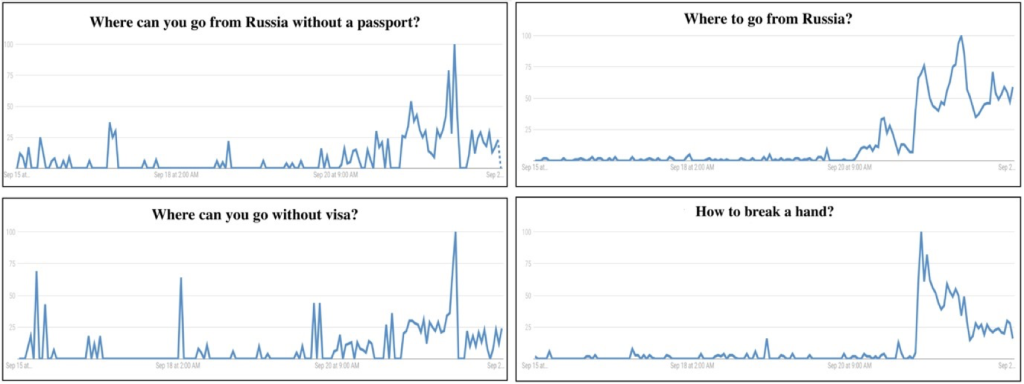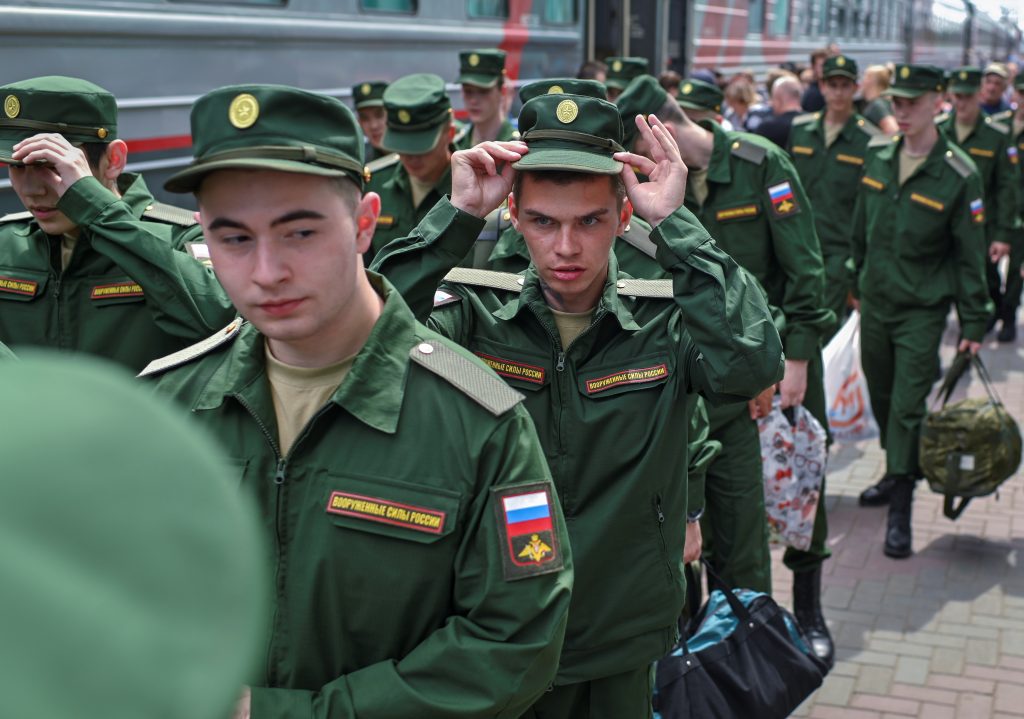As Russia continues its assault on Ukraine, the Atlantic Council’s Digital Forensic Research Lab (DFRLab) is keeping a close eye on Russia’s movements across the military, cyber, and information domains. With more than seven years of experience monitoring the situation in Ukraine—as well as Russia’s use of propaganda and disinformation to undermine the United States, NATO, and the European Union—the DFRLab’s global team presents the latest installment of the Russian War Report.
Security
Russia conducts partial mobilization amid battlefield losses
Documenting dissent
Russians protest and flee the country as partial mobilization announced
War crimes and human rights abuses
Sri Lankans trapped in Kharkiv accuse Russia of torture
Russia conducts partial mobilization amid battlefield losses
As the DFRLab noted in last week’s report, Ukraine’s advancements in eastern Ukraine would put pressure on Russian President Vladimir Putin to compensate for the Kremlin’s military losses. On Wednesday, September 21, Putin declared a partial mobilization in the country, vowing to use “all means necessary” to achieve Russia’s aims against Ukraine and the West. Putin’s declaration provoked worldwide condemnation.
Russian Defense Minister Sergei Shoigu said a total of 300,000 reservists would be called up into service. He said the country’s pool of potential recruits “amounts to 25 million people, and a little more than one percent of this number falls under partial mobilization.” Cadets could also be called to duty if they have an in-demand specialty, added Andrei Kartapolov, head of the State Duma Defense Committee. He noted that officers who are under 45 years old, as well as soldiers, foremen, and warrant officers under 35, would mobilize first.
According to unconfirmed reports from Ukrainian media, volunteer battalions have already been formed in the Russian regions of Vladivostok, Kirov, Voronezh, Chuvashia, and Bashkiria. On September 16, authorities in Vladivostok announced they were sending letters to men with military experience between the ages of 25 and 63, inviting them to join the BARS (БАРС) reserves unit. Russian media reported that volunteers would receive a salary of 220,000 rubles ($3,500), allowances of 200,000 rubles ($3,300), and awards of up to 300,000 rubles ($4,900) for the destruction of Ukrainian equipment or killing of servicemen; they would also receive official veteran status, giving them access to additional state benefits. To further incentivize Russians, the ruling party proposed that academic leave for students participating in the army would be guaranteed.
In Kirov, Governor Alexander Sokolov announced the creation of the Shironin Battalion, named after Soviet war hero Peter Shironin. Sokolov said a previous battalion had already departed for Ukraine. Magadan Governor Sergey Nosov announced financial support for self-mobilization and called on people to recruit even in the smallest of Russia’s regions. Meanwhile, the leaders of Voronezh, Chuvashia, and Bashkiria also reported mobilizations were underway and that 1,000 volunteers from each of these areas had already joined the army.
The mobilization of civilian efforts did not stop there. According to the Russian branch of Radio Free Europe/Radio Liberty, employees of Gazprom are being forced to contribute at least 1,000 rubles ($17) for medication for Russian soldiers wounded in Ukraine. According to RFE journalist Mark Krutov, workers from the gas giant based in Yakutia have previously received messages asking them to contribute funds, but this is the first instance of a mandatory “crowdfunding” effort. These measures are likely the result of growing supply problems within the Russian army, which lacks vital materials, including medicine.
Russian casualty statistics remain unclear, as the Kremlin has not released updates since March 25, when the Russian Ministry of Defense reported that losses in Ukraine exceeded 5,000. On September 5, UK Defense Minister Ben Wallace said 25,000 Russian soldiers had died in Ukraine, while another 80,000 soldiers had been wounded, taken prisoner, or refused to participate in the war.
Not long after the mobilization was announced, Russia approved a law that would provide Russian citizenship to foreigners who fight on behalf of Moscow for at least one year. On September 20, information emerged that the reception of foreigners for military service in Russia would begin at the Sakharovo Migrant Center in Moscow. The center is intended for refugees from Africa, the Middle East, and former Soviet republics, but Moscow authorities have now opened a military bureau inside the center. Moscow had previously proposed that foreign recruits would receive a Russian passport in exchange for three years of service.
Alongside the mobilization announcement, Russia activated its proxies in the occupied Ukrainian territories. On September 19, the Donetsk and Luhansk People’s Republics announced plans to hold a referendum on accession to Russia. One day later, Volodymyr Saldo, the head of the Kherson wartime administration, also announced a referendum on joining Russia.
Meanwhile, a video emerged on September 16 showing a BARS-16 fighter thanking Russia for the aid sent to the frontlines. BARS-16 is known as the Kuban Unit and currently has about 1,000 fighters, with 400 soldiers located in Lyman. The unit is well regarded in Russia, with media presenting the unit, made up of Kuban Cossacks, as a key social pillar supporting Russia in the war. This indicates that moving forward the Kremlin will likely rely on smaller, motivated military units.
Meanwhile on the frontlines, the Ukrainian Navy reported that four Russian warships equipped with up to thirty two Kalibr missiles are combat-ready in the Black Sea. At the same time, Ukrainian special forces, particularly the Kraken unit, crossed the strategic Oskil river and reached the eastern part of Kupiansk.
Elsewhere, Ukraine’s 93rd Brigade said Russia had lost a T-80U-series tank, meaning Russia’s 4th Tank Division has lost a full regiment’s worth of tanks, according to Rob Lee, senior fellow at the Foreign Policy Research Institute. Lee added that Russia only has two remaining tank regiments.
Lastly, according to Ukraine’s 92nd Mechanized Brigade, the Iranian-made Shahed-136 drone has already destroyed two 152mm self-propelled howitzers, two 122mm self-propelled howitzers, and two BTR armored infantry vehicles.
—Ruslan Trad, Resident Fellow for Security Research, Sofia, Bulgaria
Russians protest and flee the country as partial mobilization announced
Following the September 21 announcement of a partial Russian mobilization, opposition figures and anti-war activists held protests in more than thirty cities across the country. More than 330,000 people have also signed an online petition against the mobilization.
The Moscow Prosecutor’s Office threatened that Russians may face administrative punishment and imprisonment of up to fifteen years for organizing, participating, or promoting anti-mobilization protests.
On the day of the announcement, police arrested at least 1,386 protesters across the country, according to OVD-Info, which monitors political persecution in Russia. In some cases, police used force against the protesters. Since the February 24 invasion of Ukraine, OVD-Info has documented more than 16,000 detentions resulting from anti-war protests and the filing of nearly 4,000 administrative complaints against the army.
Soon after Putin announced the partial mobilization, some Russians sought to flee the country, mostly to destinations that permit visa-free travel. “Virtually all flights from Russia to available foreign destinations in the coming days were sold out on Wednesday,” the Moscow Times reported. Deutsche Welle noted there was also high demand for domestic tickets to border cities where Russians could cross a land border. A video from Radio Free Europe showed a long traffic jam at the Russia-Georgia border crossing on Wednesday evening.
Anastasia Burakova, founder of the Ark Project, which helps Russians who have fled the country due to the Ukraine war, told Current Times that all flights to Kazakhstan, Armenia, and Kyrgyzstan, where Russians can enter without a visa, were sold out for the coming days. Meanwhile, Serbian President Aleksandar Vučić remarked, “Moscow-Belgrade flight ticket jumped to almost €9,000 on the black market because of the mobilization, and many other reasons.”
A Google Trends analysis for September 21 revealed a spike in searches for questions including “where can you go from Russia without passport” (“Kуда можно уехать из россии без загранпаспорта”); “where can you go without a visa” (“Kуда можно поехать без визы”); “where to go from Russia” (“Kуда уехать из россии”), and “how to break a hand” (“Kак сломать руку”). This indicates that Russians were actively searching for ways to leave the country, or possibly even injure themselves to avoid service.

On the day of the announcement, rumors emerged on social media that Russian airlines had stopped selling tickets to Russian men aged 18 to 65 who could not provide a certificate showing military enrollment. However, several airlines, including Aeroflot, Pobeda, and S7 Airlines, confirmed to Russian media that there were no restrictions on ticket sales. Russia’s rail service also confirmed there were no restrictions on their ticket sales.
—Givi Gigitashvili, Research Associate, Warsaw, Poland.
Sri Lankans trapped in Kharkiv accuse Russia of torture
Seven Sri Lankan citizens, including six men and one woman, were held captive in Vovchansk, Kharkiv Oblast, during the Russian occupation of the city. The former prisoners told Ukrainian media that they were tortured, starved, and humiliated.
The Sri Lankan citizens arrived in Ukraine three weeks before Russian invaded the country, according to Serhii Bolvinov, chief of the investigation department of the national police of Kharkiv.
Investigator Volodymyr Yakimenko said an investigation is being carried out under Part 1 of Article 438 of the Criminal Code of Ukraine, which deals with violations of the law and customs of war.
—Ruslan Trad, Resident Fellow for Security Research, Sofia, Bulgaria
Image: Conscripts, wearing military uniforms, board a train carriage at a local railway station during their departure for the garrisons, in Omsk, Russia June 17, 2022. REUTERS/Alexey Malgavko
